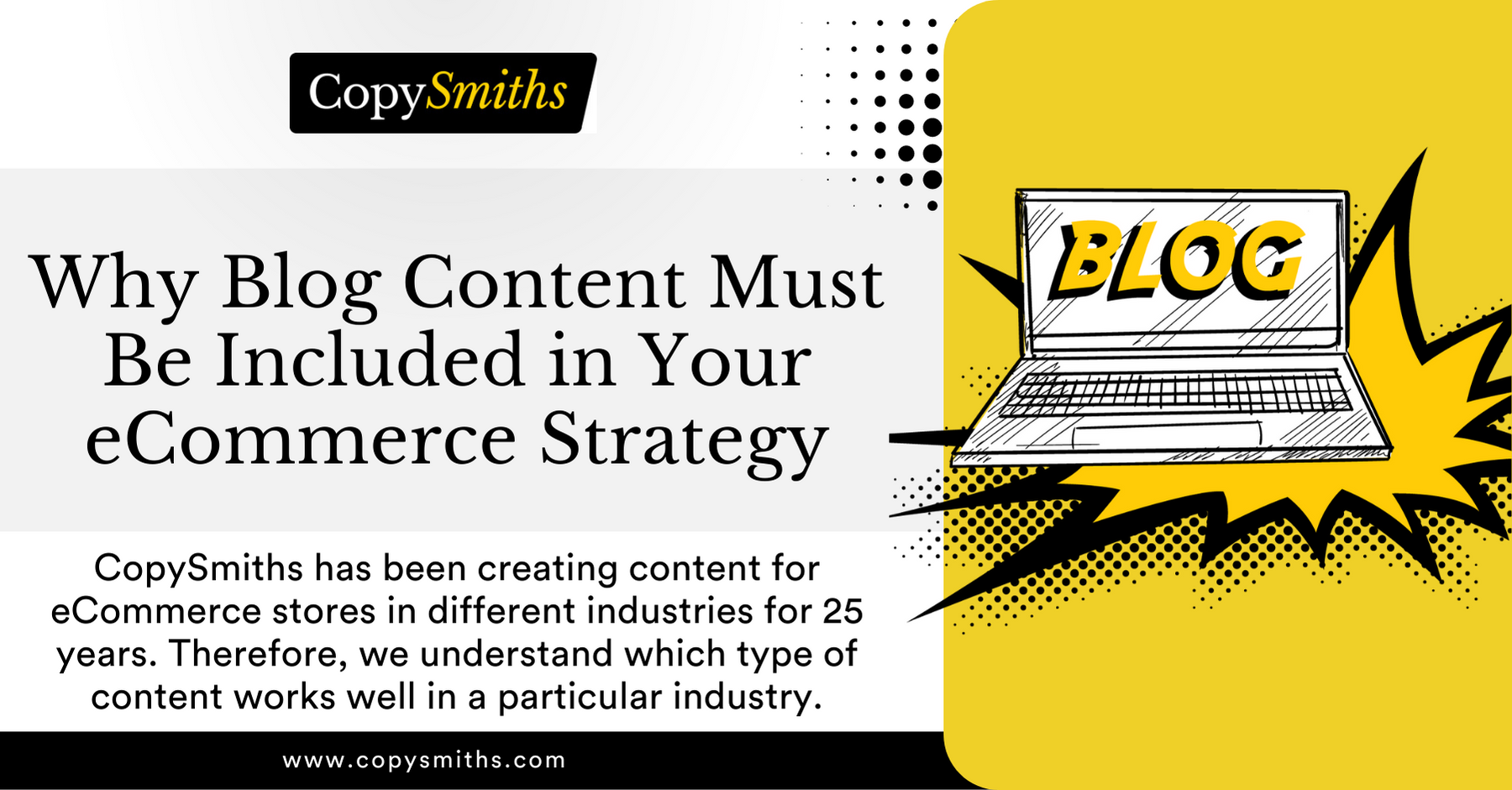Home » Content Marketing » Why Blog Content Must Be Included in Your eCommerce Strategy

Why Blog Content Must Be Included in Your eCommerce Strategy
There are many aspects to an effective eCommerce strategy, from SEO to social media marketing and paid advertising. One element that’s often overlooked is blog content.
When most eCommerce owners hear about creating blog content, they ask themselves questions like:
- Why do I need a blog? Isn’t my website enough?
- What will I write about on my blog?
- Who will read my blog?
These are all valid questions, and ones you need to ask yourself before creating your eCommerce strategy. A general answer to these questions is that blog content is an essential piece of your marketing and sales puzzle that enables you to achieve several eCommerce goals.
Said goals are illustrated by the following four reasons.
1: Blog Content Helps Your Website Rank High in Search Engines
To get organic website visitors from search engines, your website needs to rank high in search engine results pages (SERPs).
Quality blog content ensures high ranking in search engines in the following ways:
- Improves the time spent by users on the page: When people enjoy the content on a page, they spend more time on the page, which lowers the bounce rate. A low bounce rate is recommended for a high ranking on SERPs.
- Establishes you as an authority: When you write quality blog content, you’re seen as an expert on the topic. This improves your website’s authority, which is another essential ranking factor.
- Targets SEO-optimized keywords: Including SEO keywords in your blog content, ensures you rank for those keywords, increasing organic traffic to your website.
- Attracts backlinks from other websites: When other websites link to your blog content, it’s seen as a vote of confidence. This boosts your website’s authority and improves its ranking.
- Increases organic traffic to your website: More traffic means a higher chance of ranking in SERPs because it’s a signal to search engines that your site is popular. Organic traffic is essential for decreasing the cost of customer acquisition and increasing the average order value of your customers.
2: To Educate Your Customers About Your Products and Services
Your audience has problems that can be solved by your products and services. However, most of them are not aware of how your products can help solve those problems.
Creating blog content helps you to create awareness about your products and services. You can use this content to educate your audience about the features and benefits of your products.
Blog content creates awareness to such an audience by:
- Talking about their problems and how you understand them
- Introducing them to your products as a solution to their problems
- Explaining how your product works and the benefits they will get by using it
- Giving a step-by-step guide on how they can use your product or service
When you educate your customers, you’re essentially moving them further down the sales funnel. They’ll be more likely to buy from you because they know that your products will help solve their problems.
It’s worth noting that creating this kind of content is not a one-time thing. You need to create informational blog posts regularly to keep your audience updated on the latest products and services that you have to offer.
“Lodge has seen a 103% increase in our Organic Search traffic this month as a direct result of working with the CopySmiths. They know what works when it comes to SEO, have a scalable team of expert content creators and were able to execute on tactical SEO campaigns. I have no hesitation in recommending them to other businesses looking to improve their web presence.” – Paul Napper, Lodge
3: To Build Trust Between You and Your Audience
Website visitors want a tone of voice that resonates with them. They want to feel that they can trust you before buying from you.
When you create blog posts, you’re giving your site visitors a glimpse into the inner workings of your business. You’re letting them know:
- Who you are
- What you stand for
- How passionate you are about solving their problems
Gaining your audience’s trust means that they can entrust you with their money. That’s because they know you’re not just out to make a sale, but you want to help them solve their problems.
The best way to build trust is through authentic and transparent blog content.
Don’t try to be someone you’re not; people can see through that. Be yourself, and let your personality shine through your writing. For example, don’t exaggerate the features of your products. Be honest about what they can and can’t do. Blog content increases the trust between you and your customers by:
- Creating a tone of voice that resonates with them
- Showing how passionate you are about solving their problems
- Being authentic and transparent in your writing
- Providing solutions to most of their problems through informational posts
- Making them believe that your products and services will solve their problems
Expert Tip: If you’re having trouble coming up with topics to write about, use CopySmiths’ copy count feature. This is an excellent tool that will give you title ideas, the number of words per article, and other aspects of content creation like quotations, tables, images, internal and outbound links.
4: To Convert Website Visitors Into Customers
Your ideal goal as an eCommerce store owner is not only to get more website traffic but also to convert that traffic into paying customers. There are various ways to go about this but creating quality blog content is the most convenient approach.
Most eCommerce websites struggle with low conversion rates, which in most cases is attributed to poor blog content strategy. This explains why the average conversion rates of these websites is 2.86%.
The table below shows a comparison of eCommerce website conversion rates in 2018:
| Quarter | Global | USA | UK |
| Q1 2018 | 2.77% | 2.60% | 3.91% |
| Q2 2018 | 2.97% | 3.08% | 3.96% |
| Q3 2018 | 2.99% | 3.05% | 4.05% |
| Q4 2018 | 3.23% | 3.44% | 3.89% |
When you create blog posts, you’re essentially creating more opportunities to showcase your products and services. For instance, including links to your products in your blog posts is one of the ways to showcase them to people. However, this is not enough to convert leads and prospects into paying customers.
Blog content can convert website visitors into customers by:
- Incorporating relevant calls-to-action: Your CTAs must not be overly pushy and need to be used a few times in the content. We recommended using two calls to action within your content: one in the middle and the other one at the end of the blog post.
- Addressing your visitors’ pain points: Your content must show that you understand their pain. From there, demonstrate how your products or services will eliminate those pain points.
- Being well-written and engaging: If your content is boring, no one will read it to the end. Make sure to write engaging headlines and subheadings, use short paragraphs, and include images and videos to break up the text.
Outsource Your Blog Content Generation to CopySmiths
As you can see, you need quality blog content to drive traffic to your eCommerce website and convert it into customers.
CopySmiths has been creating content for eCommerce stores in different industries for 25 years. Therefore, we understand which type of content works well in a particular industry.
We handle everything from content ideation, writing, optimizing, and publishing it on your website.
If you want quality blog content at scale for your eCommerce store, contact us to get started today.
Here is what one of our customers had to say:
“I am very happy with your company’s content output and professionalism. I will be recommending use of your company’s services.” – Chris Boggs, Band-Tees.com
Frequently Asked Questions
What is the importance of a blog in eCommerce?
A blog is important in eCommerce because it helps build trust between the store and its customers, helps drive traffic to the website, and creates awareness about how the store’s products and services will solve customers’ problems.
Why is content marketing important for eCommerce?
Content marketing is important for eCommerce because it covers all aspects of the buyer’s journey. Through eCommerce content marketing, you will establish deep and authentic relationships with your customers.
What are some of the best practices for content marketing in eCommerce?
Some of the best practices for content marketing in eCommerce include creating quality blog posts that are well-written, engaging, and informative, using relevant calls-to-action in the content, and directly addressing customers’ pain points.
Share on LinkedIn:
CopySmiths
I'm Katrina McKinnon, founder of CopySmiths and Small Revolution. In my 20 years of experience, I have helped online businesses create high-performing content specifically on an eCommerce store's blog. Find me on LinkedIn and Twitter.

CopySmiths offers the best blog writing services for online stores.
If you'd like us to write blog articles for you, click here.
Most Recent
- 3 Bold Questions You Should Ask When Hiring A Content Writer

- 5 Practical Reasons You Should Use a Blog Post Template

- 4 Amazing Benefits of Using a Title Generator for New eCommerce Blogs

- 10 Awesome Bio Examples Your Online Store Blog Should Emulate

- 8 Basic Steps to Successful Content Development Every Time

Podcasts
Got a question?
Ask our friendly team about our article writing services.
Subscribe to CopyZine
Monthly, hand-picked stories of the best in eCommerce Content.





